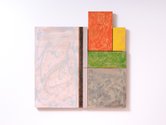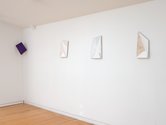John Hurrell – 14 December, 2020
This show of mainly recent formally diverse paintings is, as the title says, a tip of the hat to Mondrian (like McCahon before him), using wood or plywood panels, incised lines, and thin, sensitively applied oil paint. The exhibition reveals a recent interest in the horizontal rectangle as a painterly format. Turbulent but faint gestures are apparent on its surfaces; twitchy bodily traces of restless energy contained within the perimeters of straight-lined saw incisions and the edges of butted together blocks.
James Ross is well known in this country as a sophisticated painter of considerable flair and daring, as well as an accomplished critic and editor. Because he is not a loud trumpeter of his own abilities, each time he exhibits his abstract works is a significant occasion for vigilant watchers of innovative research. Word gets round. They make an effort to check him out.
This show of mainly recent (but all post 2012) formally diverse paintings is, as the title says, a tip of the hat to Mondrian (like McCahon before him), using wood or plywood panels, incised lines, and thin, sensitively applied oil paint. Agitated expressionism within the irregularly gridded structures of Neoplasticism.
The exhibtion reveals a recent interest in the horizontal rectangle as a painterly format. Turbulent but faint gestures are apparent on its surfaces; twitchy bodily traces of restless energy contained within the perimeters of straight-lined saw incisions and the edges of butted together blocks.
In the narrow upstairs gallery, Ross has added a small dividing wall to create some extra corners into which he also nestles three tilted and layered, diamond-shaped works. There are nineteen paintings in all—including two of the earlier glass sheet incorporated variety—and with this exhibition, the artist and Two Rooms have provided a free publication: a fascinating illustrated booklet (28pp) of notes on his working methods, with favourite quotes and points around various thematic preoccupations.
As you would expect with Ross, the presented butted together multi-panel works are full of nods to art history: Turner, Matisse, Malevich, Diebenkorn, Woollaston and Peebles are obvious names that come to mind. And brightly lit pastoral landscape (sky, fields, sea) too; a surprise considering that many of Ross‘s earlier paintings featured female forms in darkened domestic rooms. There are far fewer hints now of the Munchian interiority that was present earlier. The psychological is still there, and some floorplans are alluded to of living spaces, but overall more playful and linked to the light-filled nonhuman outdoors world.
One of the surprises in the booklet is this obviously inspirational quote from Wittgenstein:
Imagine a painting cut up into small, almost monochromatic bits which are then used as a jig-saw puzzle. Even when such a piece is not monochromatic it should not indicate any three-dimensional shape, but should appear as a flat colour-patch. Only together with the other pieces does it become a bit of blue sky, a shadow, a high-light, transparent or opaque, etc.
Looking at Ross’s later rectangular works, you can see the connection more clearly than with the earlier (under glass) diamond-shaped ones: perpendicular and horizontal cut lines—lines that sometimes stop halfway across traversed spaces; carefully positioned smaller vertical oblongs; deliberate jumps in the upper ‘flushed’ edges from those inserted blocks; beguiling swirling feathery surfaces within delicate ‘patches’ of paint application.
The varied contents of this highly nuanced exhibition provide a lot to think about in terms of formal attributes, choice of materials and tools, art history, and nature-based associations. With the helpful gratis publication it is a particularly rewarding presentation to visit.
John Hurrell




















 Two Rooms presents a program of residencies and projects
Two Rooms presents a program of residencies and projects Advertising in this column
Advertising in this column



This Discussion has 0 comments.
Comment
Participate
Register to Participate.
Sign in
Sign in to an existing account.